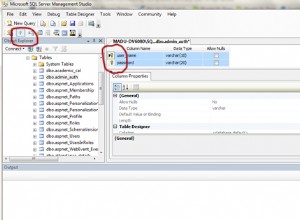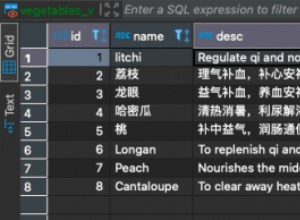हाँ; LEAD() . का उपयोग करके विश्लेषणात्मक फ़ंक्शन, आप नौकरियों और लाभ तालिकाओं में अगले effdt की गणना कर सकते हैं, जिससे श्रेणियों के बीच क्वेरी करना आसान हो जाता है।
कुछ इस तरह:
with dates as (select trunc(sysdate, 'yyyy') - 1 + level the_date,
to_number(to_char(trunc(sysdate, 'yyyy') - 1 + level, 'mm')) monthofyear,
to_number(to_char(sysdate, 'yyyy')) calendar_year
from dual
connect by level <= 365),
jobs as (select 123 emplid, to_date('01/02/2015', 'dd/mm/yyyy') effdt, 900 deptid, 'A' hr_status from dual union all
select 123 emplid, to_date('30/06/2015', 'dd/mm/yyyy') effdt, 900 deptid, 'I' hr_status from dual union all
select 123 emplid, to_date('01/08/2015', 'dd/mm/yyyy') effdt, 901 deptid, 'A' hr_status from dual),
benefits as (select 123 emplid, to_date('01/03/2015', 'dd/mm/yyyy') effdt, 'PPO' benefit_plan, 'A' status from dual union all
select 123 emplid, to_date('31/07/2015', 'dd/mm/yyyy') effdt, null benefit_plan, 'I' status from dual union all
select 123 emplid, to_date('01/09/2015', 'dd/mm/yyyy') effdt, 'HMO' benefit_plan, 'A' status from dual),
-- ********* end of mimicking your tables ********* --
j as (select emplid,
effdt,
deptid,
hr_status,
lead(effdt, 1, sysdate) over (partition by emplid order by effdt) next_effdt
from jobs),
b as (select emplid,
effdt,
benefit_plan,
status,
lead(effdt, 1, sysdate) over (partition by emplid order by effdt) next_effdt
from benefits)
select distinct j.emplid,
d.calendar_year,
d.monthofyear,
j.deptid,
b.benefit_plan
from j
inner join dates d on (d.the_date >= j.effdt and d.the_date < j.next_effdt)
inner join b on (j.emplid = b.emplid)
where d.the_date <= sysdate
and d.the_date between to_date (:year_prompt || '01-01', 'YYYY-MM-DD')
and to_date (:year_prompt || '12-31', 'YYYY-MM-DD') -- if no index on d.the_date, maybe use trunc(the_date, 'yyyy') = :year_prompt
and b.status = 'A'
and d.the_date between b.effdt and b.next_effdt
order by 1, 4, 2, 3;
EMPLID CALENDAR_YEAR MONTHOFYEAR DEPTID BENEFIT_PLAN
---------- ------------- ----------- ---------- ------------
123 2015 3 900 PPO
123 2015 4 900 PPO
123 2015 5 900 PPO
123 2015 6 900 PPO
123 2015 7 900 PPO
123 2015 9 901 HMO
123 2015 10 901 HMO
123 2015 11 901 HMO
(जाहिर है, आप dates . को बाहर कर सकते हैं , jobs और benefits उपरोक्त क्वेरी से उपश्रेणियाँ, क्योंकि आपके पास पहले से ही वे तालिकाएँ हैं। वे वास्तव में टेबल बनाने की आवश्यकता के बिना उस डेटा के साथ टेबल होने का अनुकरण करने के लिए क्वेरी में मौजूद हैं।)।
ईटीए:यहां एक संस्करण है जो उस वर्ष के आधार पर 12 महीनों की गणना करता है, जो 365/366 पंक्तियों के बजाय दिनांक पंक्तियों को घटाकर 12 कर देता है।
दुर्भाग्य से, आपको एक ही महीने में एक से अधिक पंक्तियों की शुरुआत होने पर ध्यान देने के लिए अभी भी विशिष्ट की आवश्यकता होगी।
उदाहरण के लिए, निम्नलिखित उदाहरण में डेटा के साथ, यदि आप विशिष्ट को हटा देते हैं, तो आपके पास महीने 6 के लिए 3 पंक्तियाँ होंगी। हालांकि, अलग-अलग पंक्तियों की संख्या पहले की तुलना में बहुत कम होगी।
with dates as (select add_months(to_date(:year_prompt || '-01-01', 'YYYY-MM-DD'), - 1 + level) the_date,
level monthofyear,
:year_prompt calendar_year -- assuming this is a number
from dual
connect by level <= 12),
jobs as (select 123 emplid, to_date('01/02/2015', 'dd/mm/yyyy') effdt, 900 deptid, 'A' hr_status from dual union all
select 123 emplid, to_date('15/06/2015', 'dd/mm/yyyy') effdt, 900 deptid, 'I' hr_status from dual union all
select 123 emplid, to_date('26/06/2015', 'dd/mm/yyyy') effdt, 900 deptid, 'A' hr_status from dual union all
select 123 emplid, to_date('01/08/2015', 'dd/mm/yyyy') effdt, 901 deptid, 'A' hr_status from dual),
benefits as (select 123 emplid, to_date('01/03/2015', 'dd/mm/yyyy') effdt, 'PPO' benefit_plan, 'A' status from dual union all
select 123 emplid, to_date('31/07/2015', 'dd/mm/yyyy') effdt, null benefit_plan, 'I' status from dual union all
select 123 emplid, to_date('01/09/2015', 'dd/mm/yyyy') effdt, 'HMO' benefit_plan, 'A' status from dual),
-- ********* end of mimicking your tables ********* --
j as (select emplid,
trunc(effdt, 'mm') effdt,
deptid,
hr_status,
trunc(coalesce(lead(effdt) over (partition by emplid order by effdt) -1, sysdate), 'mm') end_effdt
-- subtracting 1 from the lead(effdt) since here since the original sql had d.the_date < j.next_effdt and we need
-- to take into account when the next_effdt is the first of the month; we want the previous month to be displayed
from jobs),
b as (select emplid,
trunc(effdt, 'mm') effdt,
benefit_plan,
status,
trunc(lead(effdt, 1, sysdate) over (partition by emplid order by effdt), 'mm') end_effdt
from benefits)
select distinct j.emplid,
d.calendar_year,
d.monthofyear,
j.deptid,
b.benefit_plan
from j
inner join dates d on (d.the_date between j.effdt and j.end_effdt)
inner join b on (j.emplid = b.emplid)
where d.the_date <= sysdate
and b.status = 'A'
and d.the_date between b.effdt and b.end_effdt
order by 1, 4, 2, 3;
EMPLID CALENDAR_YEAR MONTHOFYEAR DEPTID BENEFIT_PLAN
---------- ------------- ----------- ---------- --------------------------------
123 2015 3 900 PPO
123 2015 4 900 PPO
123 2015 5 900 PPO
123 2015 6 900 PPO
123 2015 6 900 PPO
123 2015 7 900 PPO
123 2015 9 901 HMO
123 2015 10 901 HMO
123 2015 11 901 HMO




